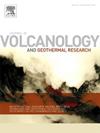Surface deformation caused by the unrest during 2002–2006 of the Changbaishan volcano in China
IF 2.4
3区 地球科学
Q2 GEOSCIENCES, MULTIDISCIPLINARY
Journal of Volcanology and Geothermal Research
Pub Date : 2024-11-15
DOI:10.1016/j.jvolgeores.2024.108234
引用次数: 0
Abstract
The Changbaishan volcano is recognized as one of China's most potentially dangerous active volcanoes. In response to the unrest event of 2002, GPS technology was utilized to monitor the surface deformation it induced. However, the understanding of the volcano's dynamics and the intricacies of GPS data at the time were limited, which affected the quality of the conclusions. For example, the commencement of GPS observations followed the escalation of seismic activities, leading to the loss of some deformation information. Moreover, observational noise in the GPS coordinate sequences introduced oscillations in the evolution of deformation characteristics. To overcome these limitations, we have developed an advanced GPS data processing methodology. This includes the establishment of a meticulous three-tier control network, the employment of high-precision geophysical models in GAMIT/GLOBK software, the creation of a volcanic regional reference frame, and the formulation of a sophisticated motion model for monitoring stations. With these approaches, we have captured the maximum surface deformation caused by the unrest and have re-evaluated the volume change (25.95× 106 m3/year) of the magma chamber based on Mogi model, yielding results that significantly surpass the mean of previous estimates of 8.58 × 106 m3/year and enhancing our understanding of the magma chamber's dimensions. Additionally, the surface deformation following the unrest displayed a pattern of continuous decay, which is in contrast to the seismic activity that initially rose and then declined, peaking notably after the surface deformation's peak. Considering the geological context of the volcano's formation, we have also provided an extensive dataset of GPS velocity fields. We have preliminarily discussed the possible relationship between the subduction of the Pacific Plate and the unrest in 2002, as well as the recent low-level unrest in 2021, acknowledging that this hypothesis requires further confirmation through stress modeling related to the disturbances. The deformation data resulting from the unrest, as well as the background deformation caused by plate subduction presented in this study, provide essential data constraints for the construction of subsequent stress models.
2002-2006 年中国长白山火山动荡引起的地表变形
长白山火山是中国公认的最危险的活火山之一。针对 2002 年的动乱事件,利用 GPS 技术对其引起的地表变形进行了监测。然而,由于当时对火山动态的了解和 GPS 数据的复杂性有限,影响了结论的质量。例如,GPS 观测是在地震活动升级之后开始的,这导致了一些变形信息的丢失。此外,全球定位系统坐标序列中的观测噪声也导致了形变特征演变过程中的振荡。为了克服这些局限性,我们开发了一套先进的 GPS 数据处理方法。这包括建立一个缜密的三级控制网络,在 GAMIT/GLOBK 软件中使用高精度地球物理模型,创建一个火山区域参考框架,以及为监测站制定一个复杂的运动模型。通过这些方法,我们捕捉到了动荡造成的最大地表变形,并根据莫吉模型重新评估了岩浆腔的体积变化(25.95×106 立方米/年),得出的结果大大超过了之前估计的 8.58×106 立方米/年的平均值,增强了我们对岩浆腔尺寸的了解。此外,动荡后的地表形变呈现出持续衰减的模式,这与地震活动形成鲜明对比,地震活动先上升后下降,在地表形变峰值后达到峰值。考虑到火山形成的地质背景,我们还提供了大量 GPS 速度场数据集。我们初步讨论了太平洋板块俯冲与 2002 年动荡以及最近 2021 年低水平动荡之间可能存在的关系,并承认这一假设需要通过与动荡相关的应力模型来进一步证实。本研究中介绍的动荡造成的变形数据以及板块俯冲造成的背景变形为后续应力模型的构建提供了重要的数据约束。
本文章由计算机程序翻译,如有差异,请以英文原文为准。
求助全文
约1分钟内获得全文
求助全文
来源期刊
CiteScore
5.90
自引率
13.80%
发文量
183
审稿时长
19.7 weeks
期刊介绍:
An international research journal with focus on volcanic and geothermal processes and their impact on the environment and society.
Submission of papers covering the following aspects of volcanology and geothermal research are encouraged:
(1) Geological aspects of volcanic systems: volcano stratigraphy, structure and tectonic influence; eruptive history; evolution of volcanic landforms; eruption style and progress; dispersal patterns of lava and ash; analysis of real-time eruption observations.
(2) Geochemical and petrological aspects of volcanic rocks: magma genesis and evolution; crystallization; volatile compositions, solubility, and degassing; volcanic petrography and textural analysis.
(3) Hydrology, geochemistry and measurement of volcanic and hydrothermal fluids: volcanic gas emissions; fumaroles and springs; crater lakes; hydrothermal mineralization.
(4) Geophysical aspects of volcanic systems: physical properties of volcanic rocks and magmas; heat flow studies; volcano seismology, geodesy and remote sensing.
(5) Computational modeling and experimental simulation of magmatic and hydrothermal processes: eruption dynamics; magma transport and storage; plume dynamics and ash dispersal; lava flow dynamics; hydrothermal fluid flow; thermodynamics of aqueous fluids and melts.
(6) Volcano hazard and risk research: hazard zonation methodology, development of forecasting tools; assessment techniques for vulnerability and impact.

 求助内容:
求助内容: 应助结果提醒方式:
应助结果提醒方式:


